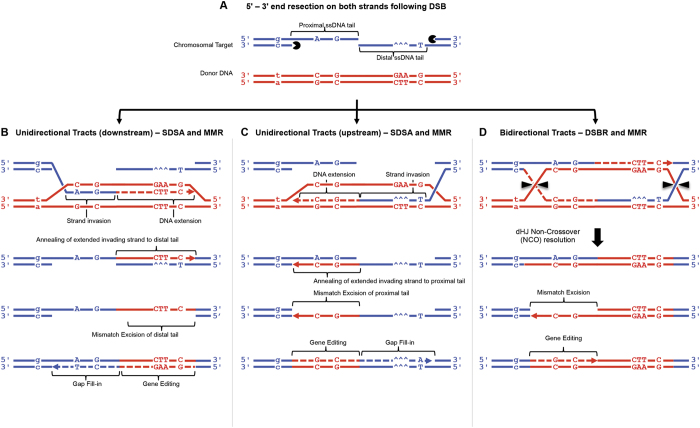Figure 3. Mechanisms of gene editing.
(A) Schematic representation of chromosomal target (blue), donor plasmid (red), SNPs and 3 bp deletion (^^^)/3 bp insertion (CTT). Target shown with 5′ ends resected and proximal/distal 3′ ssDNA tails exposed. Donor DNA is shown with the top strand in the 3′-5′ direction. (B) Mechanism of unidirectional tract repair occurring downstream of the DSB. The proximal ssDNA tail invades the donor DNA creating a D-loop, and the invading strand extends incorporating CTT and C SNP from the donor. Once sufficiently extended, the invading strand leaves donor and anneals to distal ssDNA in chromosome creating gapped duplex. Following mismatch removal (from same strand as the gap), DNA synthesis by pol δ would result, in this example, in a downstream editing tract containing both the CTT sequence and C SNP. (C) Mechanism of unidirectional tract repair occurring upstream of the DSB. The distal ssDNA tail invades the donor DNA creating a D-loop, and the invading strand extends incorporating G and C SNPs from the donor (reading in the 5′-3′ direction). Once sufficiently extended, the invading strand leaves the donor and anneals to the proximal ssDNA tail in chromosome creating a gapped duplex. Following mismatch removal (from same strand as the gap), DNA synthesis by pol δ would result, in this example, in an upstream editing tract conaining the G and C SNPs closest to the DSB are edited, whereas the g SNP in the intron is not edited. Longer or shorter tracts are explained by length of DNA extension prior to annealing with the ssDNA tails. (D) Mechanism of bidirectional tract repair spanning both sides of the Cas9 can be initiated by either of the ssDNA tails; this example starts with distal ssDNA tail invasion creating a D-loop, and incorporation of SNPs from the donor as before. Rather than collapse, the D-loop expands and captures the second strand as a template for DNA synthesis resulting in two Holliday junctions (HJs). Non-crossover resolution creates an edited downstream tract, with heteroduplex DNA in the upstream region processed by mismatch removal and DNA synthesis to complete the editing process.

